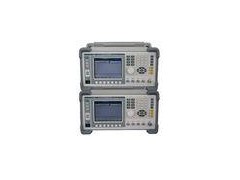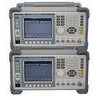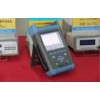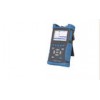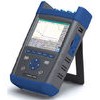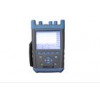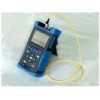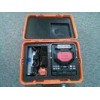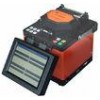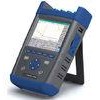Digital Step Microwave Signal Generator 1Hz Frequency Resolution
Product Overview
AV1476A/AV1476B Microwave Signal Generator is a military electronic measuring instrument, mainly used for the detection, maintenance and training guarantee of modern electronic warfare equipment, with multiple modulation systems.
And it can not only be used as a common signal generator but also realize the analog generation of multiple complex signals in communication, radar and navigation etc. as well as can be edited to generate specific signal mode according to actual demand so as to apply to more occasions. In particular, it is also designed with shortcut key of special functions for the convenience and flexibility of operation.
Main Features:
1. 1Hz frequency resolution;
2. Microsecond fast frequency hopping ability;
3. Wide dynamic range of power and high power accuracy;
4. Digital baseband signal generation and vector modulation;
5. Multiple radar signal analog capability;
6. Programmable capability of some complex signal;
7. Built-in digital synthesis modulation source .
Technical Specifications:
| Product model | AV1476A | AV1476B |
| Frequency range | 250kHz ~ 3GHz | 50MHz ~ 18GHz |
| Frequency resolution | 1Hz | 1Hz |
| Power accuracy | ±1.2dB (-10dBm ~ +10dBm) | ±1.2dB (-10dBm ~ +5dBm) |
| Stable amplitude power range | -110dBm ~ +10dBm | -110dBm ~ +5dBm |
| SSB phase noise | -90dBc/Hz (1GHz, 20kHz frequency offset) | -90dBc/Hz (10GHz, 100kHz frequency offset) |
| Frequency hopping rate | 2000h/s | 2000h/s |
| Frequency switching time | ≤ 100μs(Sequence hopping) | ≤ 100μs(Sequence hopping) |
| Frequency hopping frequency range | Maximum 60MHz | Maximum 60MHz |
| Max number of frequency hopping channel | 8000 | 8000 |
| Digital modulation format | BPSK, QPSK, MSK, 2FSK, 4FSK | BPSK, QPSK, MSK, 2FSK, 4FSK |
| RB | 1kHz ~ 2MHz | 1kHz ~ 2MHz |
| Modulation bandwidth | 10MHz | |
| Pulse PRF jittering | 1% ~10% | |
| Antenna beam | Sinx/x function in shape | |
| Antenna sweep simulation cycle | 300ms ~ 20s | |
| Audio frequency output | 10Hz ~ 400kHz | 10Hz ~ 400kHz |
| Input port | 10MHz external reference, AM input, PM input | 10MHz external reference, AM input, PM input |
| Output port | N-type female - 50Ω impedance, frequency hopping synchronous output, AF output, (BNC-50Ω female), I/Q circuit input/output | SMA male - 50Ωinpedance, frequency hopping synchronous output, AF output, (BNC-50Ω female), I/Q circuit input/output |
| Interface characteristics | GPIB interface, complied with the requirements of IEE-488 interface Fast frequency hopping bus interface: 25-core D-type female connector LAN interface USB interface |
GPIB interface, complied with the requirements of IEE-488 interface Fast frequency hopping bus interface: 25-core D-type female connector LAN interface USB interface |
| Power supply | AC220V ±10%, 50Hz±5% Power consumption 200W |
AC220V ±10%, 50Hz±5% Power consumption 200W |
| Dimensions | L×W×H = 360×515×177 | L×W×H= 360×515×177 |
| Weight | 25kg | 25kg |
Ordering Information:
Main unit: AV1476A/AV1476B Microwave Signal Generator
1. Microsecond fast frequency hopping ability
Frequency bandwidth is up to 60MHz, and frequency hopping rate is up to over 2000h/s, which can meet most frequency agility applications.
2. Wide dynamic range of power and high power accuracy
Dynamic range of output power is up to more than 120dB with high power accuracy so as to flexibly analog signal transmission in space and amplitude strength.
3. Multiple sweep modes: digital step, frequency hopping, phase continuation
Digital step sweep has main advantages of wide range of sweep frequency, frequency synthesis, checking the characteristics of wideband radio frequency device quickly and finishing the detection of wideband RF devices such as wideband filter, RF amplifier, mixer etc. quickly.
4. Frequency modulation/Amplitude modulation/Phase modulation/Pulse modulation and Compound modulation
It offers multiple compound simultaneous modulations.
(1) Amplitude modulation: frequency modulation, phase modulation; Frequency modulation: amplitude modulation, pulse modulation;
(2) Phase modulation: amplitude modulation, pulse modulation; Pulse modulation: frequency modulation, phase modulation.
5. Digital baseband signal generation and vector modulation
Digital baseband signal generation and vector modulation offer multiple digital modulation modes including BPSK, QPSK, 2FSK, 4FSK and MSK. Communications signals that user requires can be generated by changing modulation mode, RB, filter form and filter coefficient etc., which is used for testing of receiver.
6. Multi radar signal analog ability
It can generate frequency agile signal, chirp signal, pulse PRF jittering, PRF staggering signal and antenna sweep analog signal etc., as well as can analog continuous wave radar, frequency agile radar, pulse compression radar, pulse PRF jittering radar, pulse PRF staggering radar and pulse Doppler radar.
7. Data transmission, communication and printing functions
With multiple communication modes such as network interface, USB interface and GPIB interface etc., waveform files can be operated by remote control through the network interface and USB interface.
8. USB interface
With fast USB interface that is plug and play and can realize storage and recall of files quickly or software upgrading of instrument, the instrument supports U disk and MP3.with protocol 1.0
Standard Configuration:
(1) Power Cord
(2) User’s Guide
(3) Certificate of Conformity
Typical Applications :

(1) Military communication and radar countermeasures are important parts of modern electronic warfare. Electronic counter reconnaissance is an important aspect of electronic countermeasure, which mainly works as the reconnaissance and receiving, interception and identification of electromagnetic signals ,in order to obtain communications signal, radar signal, navigation signal and satellite communication signal etc.
(2) It can further analyze enemy’s weapon station of radar and hand radar and technical parameters of radar guidance weapon system or wireless communication system as well as military deployment condition, so as to guide our army electronic interference equipment to carry out electronic interference, electronic spoofing and electronic attack to the enemy for the purpose of weakening and destroying the operational effectiveness of enemy’s electronic system. The working frequency of modern communication receiving equipment covers shortwave and ultra-short wave.

